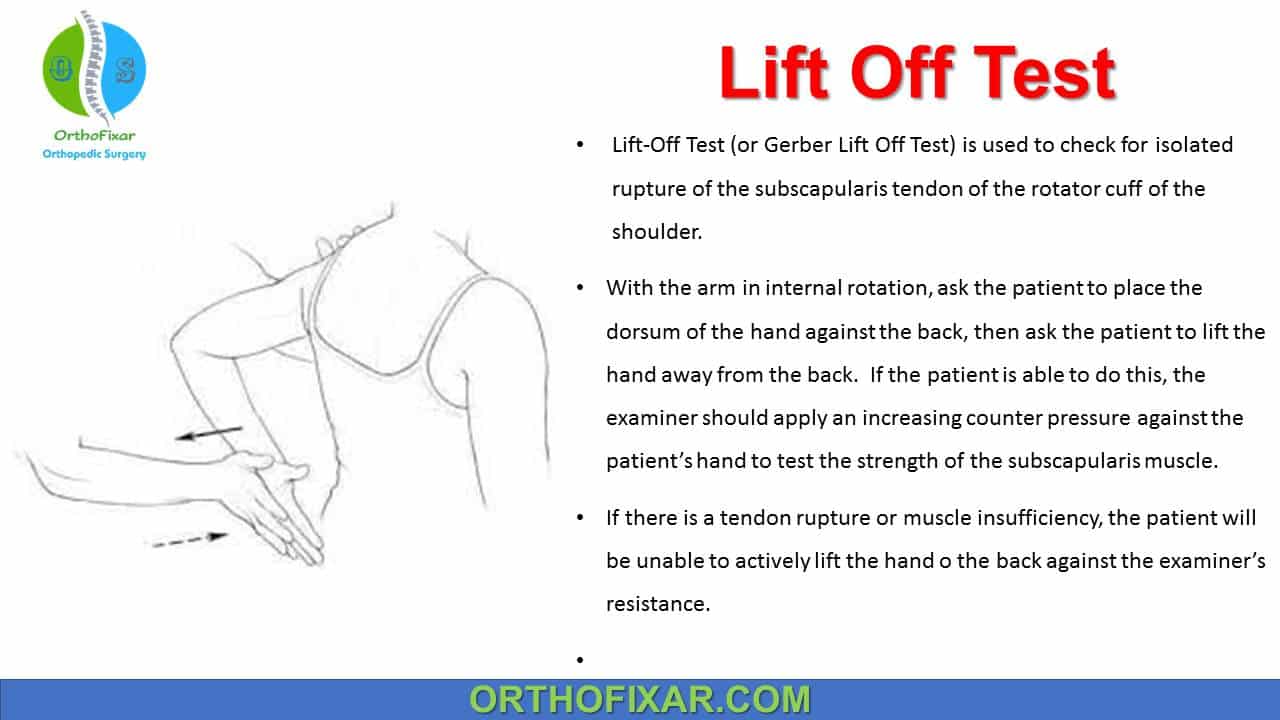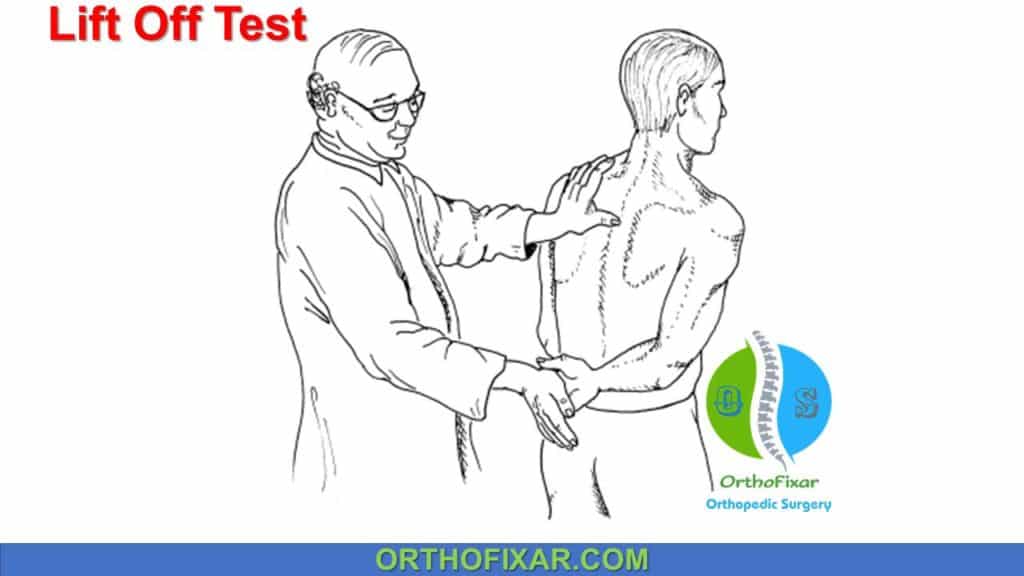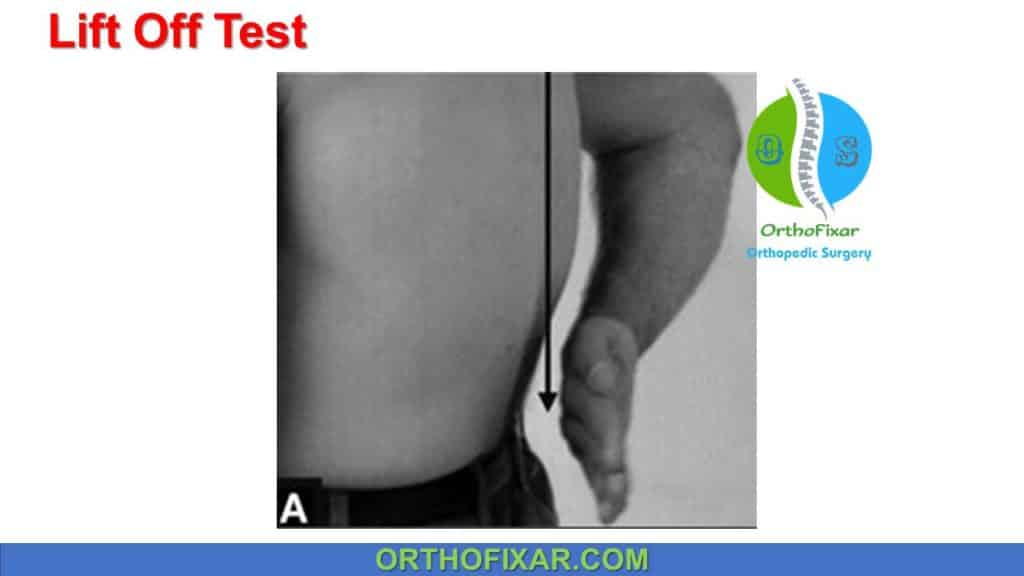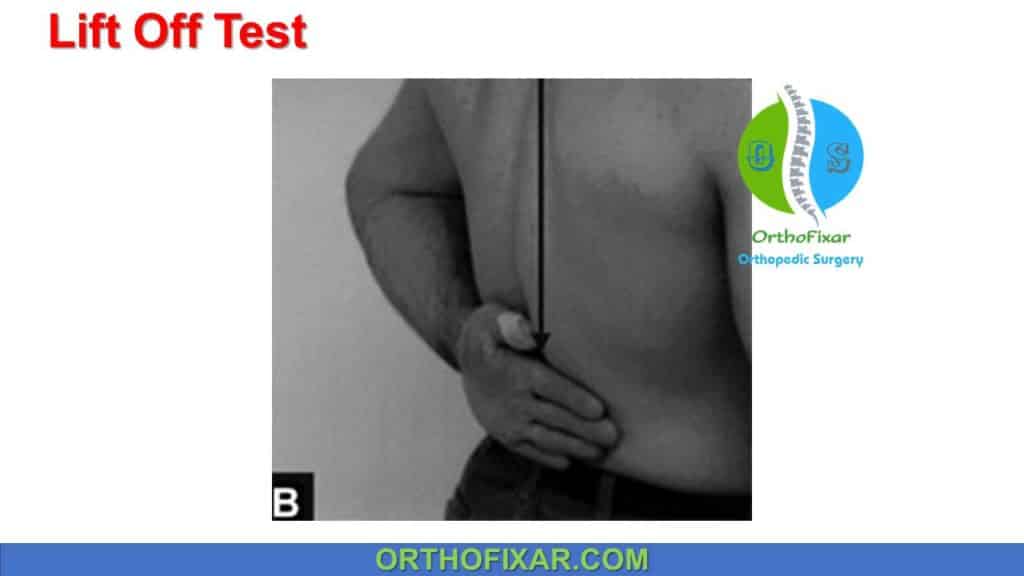Lift Off Test

Lift Off Test (or Gerber Lift Off Test) is used to check for isolated rupture of the subscapularis tendon of the rotator cuff of the shoulder. This test was first described by Gerber and Krushell.
Another special tests for subscapularis tendon is Belly Press Test, Internal Rotation Lag Sign and Bear Hug Test.
See Also:
How do you perform the Lift Off Test?
- The patient is standing with the GH joint internally rotated and extended, and the elbow flexed The dorsal surface of the hand is placed against the midlumbar spine, while the examiner standing behind the patient.
- The examiner asks the patient to lift the hand away from the back.
- If the patient is able to do this, the examiner should apply an increasing counter pressure against the patient’s hand to test the strength of the subscapularis muscle.

What does a positive Lift Off Test mean?
- If there is a subscapularis tendon rupture or muscle insufficiency, the patient will be unable to actively lift the hand on the back against the examiner’s resistance (Positive Lift off test), or if patient performs the lifting maneuver by extending the elbow or the shoulder.
- Where pain renders maximum internal rotation impossible, the belly press test may be performed.
Based on our interpretation of the results presented by Hertel et al. , it may be possible for an experienced examiner to estimate the extent of subscapularis involvement by judging the amount of applied force necessary to cause the humerus to externally rotate. Theoretically, a smaller applied force would suggest less involvement whereas a stronger applied force would suggest greater involvement.
See Also: Belly Press Test


Accuracy
The Lift Off Test has been found to have a high sensitivity and specificity for a tear of the subscapularis tendon1:
- Sensitivity: 80 %
- Specificity: 100 %
Another study by Márcio Schiefer addressed that lift off test has a low Sensitivity (25 %) and high Specificity (92 %) 2 .
Diagnostic Utility of the Lift Off Test in Identifying Subacromial Impingement:
| Population | Reference Standard | Sens | Spec | +LR | -LR |
|---|---|---|---|---|---|
| Pooled estimates from four studies (n = 267) | Impingement syndrome diagnosed by arthroscopy | .42 (.19, .69) | .97 (.79, 1.0) | 14 | .60 |
| 30 patients with new onset of shoulder pain | Subacromial impingement confirmed by MRI | .68 | .50 | 1.4 (.70, 2.7) | .64 |
| 30 patients with new onset of shoulder pain | Subacromial bursitis confirmed by MRI | .93 | .71 | 3.3 (1.4, 7.6) | .10 |
| 847 patients who underwent diagnostic arthroscopy of the shoulder | Partial biceps tendon tear visualized during arthroscopy | .28 | .89 | 2.5 | .81 |
Diagnostic Utility of Lift Off Test for Identifying Subscapularis Tears:
| Population | Reference Standard | Sens | Spec | +LR | -LR |
|---|---|---|---|---|---|
| 312 patients scheduled to undergo arthroscopic shoulder surgery | Subscapularis tear diagnosed via arthroscopic visualization | .12 | 1.0 | Undefined | .88 |
| 68 shoulders scheduled to undergo arthroscopic surgery | Subscapularis tear diagnosed via arthroscopic visualization | .18 | 1.0 | Undefined | .82 |
Note
- Test should be performed only if the patient has sufficient internal rotation to reach the sacral region or above.
- Because many patients with biceps subluxations also have partial or full-thickness tears of the subscapularis, a positive lift off test compels one to think of biceps tendon pathology as well.
- With a torn subscapularis tendon, passive (and active) external rotations will be more.
- Medial border winging of the scapula during the test may indicate that the rhomboids are affected
- Stefko et al. 3 reported that maximum isolation of the subscapularis was achieved by placing the hand against the posteroinferior border of the scapula and then attempting the lift off. In the other positions for lift off, teres major, latissimus dorsi, posterior deltoid, or rhomboids may compensate for a weak subscapularis.
- The strength of the latissimus dorsi (which primarily functions to extend and internally rotate the humerus) may overpower that of a torn subscapularis, possibly allowing some patients to demonstrate adequate strength with this test.
Reference
- Gerber C, Krushell RJ: Isolated rupture of the tendon of the subscapularis muscle: clinical features in 16 cases. J Bone Joint Surg 73B:389–394, 1991. PMID: 1670434.
- Márcio Schiefer, Yonder Archanjo Ching-San Júnior, Sérgio Maurício Silva, César Fontenelle, Marcos Genúncio Dias Carvalho, Fabio Garcia de Faria, and José Sérgio Franco: CLINICAL DIAGNOSIS OF SUBSCAPULARIS TENDON TEAR USING THE BEAR HUG SEMIOLOGICAL MANEUVER. Rev Bras Ortop. 2012 Sep-Oct; 47(5): 588–592. PMID: 27047870
- Stefko JM, Jobe FW, Vanderwilde RS, Carden E, Pink M. Electromyographic and nerve block analysis of the subscapularis lift off test. J Shoulder Elb Surg. 1997;6:347–55.
- Alqunaee M, Galvin R, Fahey T. Diagnostic accuracy of clinical tests for subacromial impingement syndrome: a systematic review and meta-analysis. Arch Phys Med Rehabil. 2012;93(2):229-236.
- Silva L, Andreu JL, Munoz P, et al. Accuracy of physical examination in subacromial impingement syndrome. Rheumatology (Oxford). 2008;47:679-683.
- Gill HS, El Rassi G, Bahk MS, et al. Physical examination for partial tears of the biceps tendon. Am J Sports Med. 2007;35:1334-1340.
- Yoon JP, Chung SW, Kim SH, Oh JH. Diagnostic value of four clinical tests for the evaluation of subscapularis integrity. J Shoulder Elbow Surg. 2013; 22(9):1186-1192.
- Barth JR, Burkhart SS, De Beer JF. The bear-hug test: a new and sensitive test for diagnosing a subscapularis tear. Arthroscopy. 2006;22:1076-1084.
- Hertel R, Ballmer FT, Lombert SM, Gerber C. Lag signs in the diagnosis of rotator cuff rupture. J Shoulder Elbow Surg. 1996;5(4):307–13.
- Campbel’s Operative Orthopaedics 13th Book
- Clinical Tests for the Musculoskeletal System, Third Edition book.
- Mark Dutton, Pt . Dutton’s Orthopaedic Examination, Evaluation, And Intervention, 3rd Edition Book.
- Millers Review of Orthopaedics, 7th Edition Book.
- Lifetime product updates
- Install on one device
- Lifetime product support
- Lifetime product updates
- Install on one device
- Lifetime product support
- Lifetime product updates
- Install on one device
- Lifetime product support
- Lifetime product updates
- Install on one device
- Lifetime product support